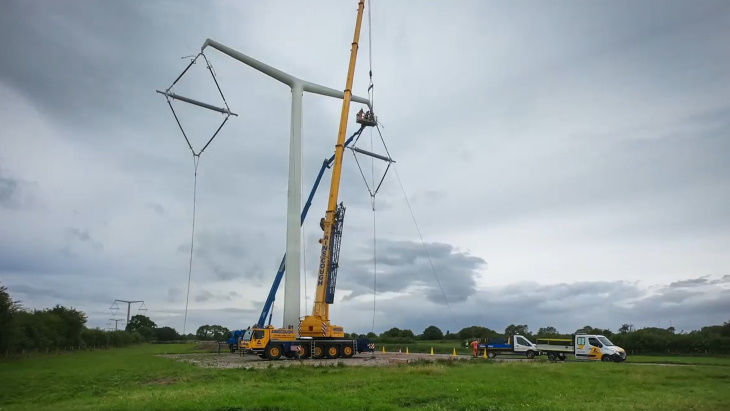
The new high-voltage 400kV overhead line featuring the new T-pylons is just one element of the Hinkley Connection, which will run from Hinkley to Seabank, near Avonmouth. The full route is made up of 14 interconnected project stages which are set for completion by 2025. It includes modifications to the existing local network by removing 67km of overhead wires (including 249 pylons) and 8.5km of underground cables through the Mendip Hills area of outstanding natural beauty, which will leave the area free of pylons for the first time since the 1960s. Construction work started in 2018.
The first T-pylon to be built was constructed in September 2021. The T-pylons were designed to reduce the visual impact of the 57km connection route on the landscape as a direct response to community feedback. Each one has a single pole and T-shaped cross arms which hold the high-voltage conductors in a diamond 'earring' shape. At 35 metres high, they are one-third shorter than National Grid's traditional lattice transmission pylons and take up less room on the land.
The last of the T-structures' 232 diamond-shaped insulators was recently lifted by crane into place on a T-pylon between Yatton and Kenn in North Somerset by National Grid and principal contractor Balfour Beatty.
National Grid said 36 new T-pylons between Woolavington and Loxton were energised in March, meaning high voltage electricity is now running along the new T-pylons, through cables under the Mendip Hills and via a newly built substation at Sandford.
At the same time, work began to build the 68 T-pylons running north of the Sandford substation to Portbury. With the hanging of the final diamond insulator, those 68 T-pylon structures are now complete.
All the T-pylons will be energised by the end of 2024. Before then, conductors will be hung from the T-pylons, and the last of 249 traditional lattice pylons and 67km of overhead wires will be removed from the landscape to make way for the new electricity connection.
"National Grid's T-pylons are the first new design for overhead electricity lines in over a century and will play a central role in connecting low-carbon energy to millions of people when Hinkley Point C begins generation," said Roxane Fisher-Redel, Senior Project Manager for National Grid on the Hinkley Connection Project. "Erecting all the 116 T-pylon structures is a huge milestone and now we look ahead to 2025 and full completion of this project, which will play such a key role in transmitting cleaner, homegrown energy around the UK - enough to power six million homes and businesses."
Hinkley Point C will be the first new nuclear power station to be built in the UK in over 20 years and will provide about 7% of the country's electricity. The first of its two EPR reactors is scheduled to be connected to the grid in 2027 and the second in 2028.